Spelman College
Spelman College is a private, liberal arts, women's college in Atlanta, Georgia, United States. The college is part of the Atlanta University Center academic consortium in Atlanta.[2] Founded in 1881 as the Atlanta Baptist Female Seminary, Spelman received its collegiate charter in 1924, making it America's oldest private historically black liberal arts college for women.[2]
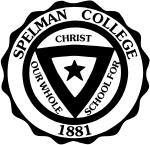 | |
Former names | Atlanta Baptist Female Seminary |
|---|---|
| Motto | Our Whole School for Christ |
| Type | Private women's college HBCU[1] |
| Established | April 11, 1881[2][3] |
| Endowment | $390.5 million (2019)[4] |
| Budget | $98.4 million (2018)[5] |
| President | Mary Schmidt Campbell |
| Students | 2,120 (Fall 2019)[6] |
| Location | , , United States 33.746°N 84.411°W |
| Colors | Columbia Blue and White[7] |
| Athletics | None[8] Formerly NCAA Division III GSAC |
| Nickname | Jaguars (former) |
| Affiliations | Annapolis Group ACS |
| Website | www |
 | |
History
Founding
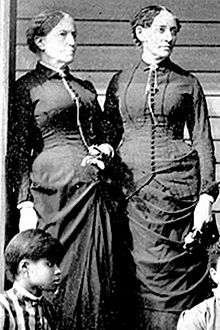
The Atlanta Baptist Female Seminary was established on April 11, 1881 in the basement of Friendship Baptist Church in Atlanta, Georgia, by two teachers from the Oread Institute of Worcester, Massachusetts: Harriet E. Giles and Sophia B. Packard.[2][9] Giles and Packard had met while Giles was a student, and Packard the preceptress, of the New Salem Academy in New Salem, Massachusetts, and fostered a lifelong friendship there.[10] The two of them traveled to Atlanta specifically to found a school for black freedwomen, and found support from Frank Quarles, the pastor of Friendship Baptist Church.
Giles and Packard began the school with 11 African-American women and $100 given to them by the First Baptist Church in Medford, Massachusetts.,[2] and a promise of further support from the Women's American Baptist Home Missionary Society (WABHMS), a group with which they were both affiliated in Boston.[10] Although their first students were mostly illiterate, they envisioned their school to be a liberal arts institution – the first circular of the college stated that they planned to offer "algebra, physiology, essays, Latin, rhetoric, geometry, political economy, mental philosophy (psychology), chemistry, botany, Constitution of the United States, astronomy, zoology, geology, moral philosophy, and evidences of Christianity".[10] Over time, they attracted more students; by the time the first term ended, they had enrolled 80 students in the seminary.[10] The WABHMS made a down payment on a nine-acre (36,000 m²) site in Atlanta relatively close to the church they began in, which originally had five buildings left from a Union Civil War encampment, to support classroom and residence hall needs.[11]
In 1882 the two women returned to Massachusetts to bid for more money and were introduced to wealthy Northern Baptist businessman John D. Rockefeller at a church conference in Ohio.[2] Rockefeller was impressed by Packard's vision. In April 1884, Rockefeller visited the school. By this time, the seminary had 600 students and 16 faculty members. It was surviving on generous donations by the black community in Atlanta, the efforts of volunteer teachers, and gifts of supplies; many Atlanta black churches, philanthropists, and black community groups raised and donated money to settle the debt on the property that had been acquired.[10] Rockefeller was so impressed that he settled the debt on the property.[11] Rockefeller's wife, Laura Spelman Rockefeller; her sister, Lucy Spelman; and their parents, Harvey Buel and Lucy Henry Spelman, were also supportive of the school. The Spelmans were longtime activists in the abolitionist movement. In 1884 the name of the school was changed to the Spelman Seminary in honor of Laura Spelman, John D. Rockefeller's wife,[2] and her parents. Rockefeller also donated the funds for what is currently the oldest building on campus, Rockefeller Hall, which was constructed in 1886.
Packard was appointed as Spelman's first president in 1888, after the charter for the seminary was granted. Packard died in 1891, and Giles assumed the presidency until her death in 1909.
Growth
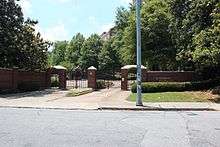
The years 1910 to 1953 saw great growth and transition for the seminary.[12] Upon Giles' death, Lucy Hale Tapley became president. Although the college was a stride in and of itself, at the time, neither the founders nor the current administration had interest in challenging the status quo of young women as primarily responsible for the family and the home.[10] Tapley declared: "Any course of study which fails to cultivate a taste and fitness for practical and efficient work in some part of the field of the world's needs is unpopular at Spelman and finds no place in our curriculum." [12] The nursing curriculum was strengthened; a teachers' dormitory and a home economics building were constructed, and Tapley Hall, the science building, was completed in 1925.[12] The Granddaughters' Club, a club for students whose mothers and aunts had attended Spelman was also created, and this club is still in existence today.
In 1927, Spelman Baptist Seminary officially became Spelman College. Florence Matilda Read assumed the presidency in 1927. Shortly thereafter, Spelman entered into an "agreement of affiliation" with nearby Morehouse College and Atlanta University by chartering the Atlanta University Center in 1929.[13] Atlanta University was to provide graduate education for students, whereas Morehouse and Spelman were responsible for the undergraduate education. At a time during which black students were often denied access to graduate studies at predominantly white southern research universities, access to Atlanta University allowed the undergraduate students at Morehouse and Spelman immediate access to graduate training.
In 1927, one of the most important buildings on campus, Sisters Chapel, was dedicated. The chapel was named for its primary benefactors, sisters Laura Spelman Rockefeller and Lucy Maria Spelman. The college had also begun to see an improvement in extracurricular investment in the arts, with the organization of the Spelman College Glee Club in 1925,[14] inauguration of the much-loved Atlanta tradition of the annual Spelman-Morehouse Christmas Carol Concert and smaller events such as the spring orchestra and chorus concert, the Atlanta University Summer Theater, and the University Players, a drama organization for AUC students. The school also began to see more of a focus on collegiate education, as it discontinued its elementary and high school divisions. In 1930 the Spelman Nursery School was created as a training center for mothers and a practice arena for students who planned careers in education and child development. Spelman celebrated its 50th anniversary in April 1931. This milestone as accompanied by the construction of a university library that was shared amongst the Atlanta University Center institutions, and the center continues to share a library to this day.
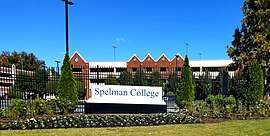
The school continued to expand, building and acquiring more property to accommodate the growing student body. IN 1947, Spelman joined the list of "approved institutions" of the Association of American Universities.[15] In 1953, Florence Read retired, and Albert E. Manley became the first black and first male president of college. Under his presidency and the presidency of his successor, Donald Stewart, Spelman saw significant growth. The college established its study abroad program, the Merrill Foreign Travel-Study Program.[13] Stewart's administration tripled the college's endowment and oversaw the establishment of the Comprehensive Writing Program, an across-the-curriculum writing program that requires students to submit portfolios of their written work; the Ethel Waddell Githii College Honors Program; and the Women's Research and Resource Center.[13] In 1958, the college received accreditation from the Southern Association of Colleges and Schools.
Civil rights involvement
Going into the 1960s, the Spelman College students became involved in the heated civil rights actions going on in Atlanta. In 1962, the first Spelman students were arrested for participating in sit-ins in the Atlanta community. Noted American historian Howard Zinn was a professor of history at Spelman during this era, and served as an adviser to the Student Nonviolent Coordinating Committee chapter at the college. Zinn mentored many of Spelman's students fighting for civil rights at the time, including Alice Walker and Marian Wright Edelman[16] Zinn was dismissed from the college in 1963 for supporting Spelman students in their efforts to fight segregation; at the time, Spelman was focused on turning out "refined young ladies." Edelman herself writes that Spelman had a reputation as "a tea-pouring, very strict school designed to turn black girls into refined ladies and teachers."[17]
1980–present
Stewart retired in 1986, and the following year, Johnnetta Betsch Cole became the first black female president of Spelman College. During this time, the college became noted for its commitment to community service and its ties to the local community. Cole also led the college's most successful capital campaign; between 1986 and 1996, the college raised $113.8 million, including a $20 million gift from Bill Cosby and his wife, Camille Hanks Cosby, whose daughter graduated from Spelman.[13] In honor of this gift, the Cosby Academic Center was constructed.[18] In July 2015 the remainder of the funds were returned and an endowed professorship named for the Cosby couple discontinued as allegations of sexual assault by Bill Cosby grew more prominent.[19][20]
In 1997, Cole stepped down and Audrey Forbes Manley became Spelman's first alumna president. After her retirement, in 2002, Beverly Daniel Tatum, the college's president until 2015, took the post. The campus now comprises 26 buildings on 39 acres (160,000 m2) in Atlanta.[3]
In 2011, First Lady Michelle Obama served as the keynote commencement speaker.[21]
In 2012, Oprah Winfrey served as the keynote commencement speaker.[21]
In March 2015, Mary Schmidt Campbell was named the 10th president of Spelman College.[22] She began her presidency August 2015.
In August 2015, Spelman opened the Wellness Center at Reed Hall, a state-of-the-art recreation center. It is host to a multitude of services from an indoor track and cycling room to a teaching kitchen and a multitude of fitness and wellness programs.[23]
In 2017, Spelman's leadership voted to allow transgender women to enroll in the institution.[24]
In 2018, Spelman received $30 million from Spelman trustee Ronda Stryker for the construction of a new state-of-the-art building on campus. Stryker's gift is the third largest single donation from a living donor to a HBCU and second largest in Spelman's history.[25][26]
In June 2020, philanthropists Reed Hastings and his wife Patty Quillin donated $40 million to Spelman College to be used as scholarship funds for students enrolled at Spelman. Their single donation is the largest in Spelman and HBCU history.[27]
Presidents

Since its inception Spelman has had ten presidents:
- Sophia B. Packard, (1888) founded women's seminary with Giles in a basement of the historic Friendship Baptist Church (Atlanta) and cultivated Rockefeller support for the school
- Harriet E. Giles, (1891) under whom the school granted its first college degrees
- Lucy Hale Tapley, (1910) under whom the school decided to focus on higher education, the school officially became Spelman College (1927), and Sisters Chapel, one of the main buildings on campus, was erected.
- Florence M. Read, (1927) a Mount Holyoke College graduate, under whom the school established an endowment fund of over $3 million, the school came into agreement with Atlanta University and Morehouse College to form the Atlanta University Center (later Clark-Atlanta University, Morris Brown College, Morehouse School of Medicine, and the Interdenominational Theological Center were added), the Arnett Library was built, and Spelman earned approval from the American Association of Universities;
- Albert E. Manley (1953) (the first black and first male president of Spelman), under whom study abroad programs were established, the fine arts center was built, and three new residence halls and several classroom buildings were renovated. According to Howard Zinn, Manley tried to suppress the student civil rights movement that was taking place on campus during his tenure.
- Donald M. Stewart (1976) under whom the departments of women's studies and chemistry were founded, and three strategic programs were formed: the Comprehensive Writing Program, the Women's Research and Resource Center, and the Ethel Waddell Githii Honors Program, and a continuing education department and a computer literacy program were established;
- Johnnetta B. Cole (1987) (the first African-American woman president of Spelman), under whom the college received $20 million from Drs. William and Camille Cosby for the construction of the Cosby Academic Center and instituted the Cole Institute for Community Service;
- Audrey F. Manley (1997) (the first alumna president of Spelman), under which Spelman gained a Phi Beta Kappa chapter, Spelman was accepted as a provisional member of NCAA Division III athletics, a Science Center was finished;
- Beverly Daniel Tatum, (2002) who was appointed in 2002 after teaching and serving as an administrator for a number of years at Mount Holyoke College, and under whom the renovation of Sisters Chapel was begun. Also during her tenure, she established the Wellness Revolution which is a holistic initiative to empower and educate Spelmanites;
- Mary Schmidt Campbell, (2015) previously a President Obama appointee who served as vice chair of the President's committee on the Arts and Humanities, she was dean emerita of the Tisch School of the Arts and Associate Provost for the Arts at New York University.
Museum of Fine Art
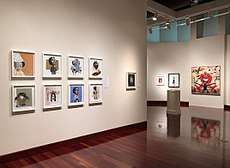
The Spelman College Museum of Fine Art is the only museum in the United States that emphasizes art by and about women of the African Diaspora.[28] Some Black Women artists the museum has featured include Amy Sherald, Mickalene Thomas, and Reneé Stout.[29] Each semester, the museum features a new exhibit; past exhibits have included artists Beverly Buchanan (2017)[30] and Zanele Muholi.
In 2016, the museum collaborated with Spelman's Department of Art and Art History to start a two-year curatorial studies program to increase diversity in the museum industry.[31]
Academics
| University rankings | |
|---|---|
| National | |
| Forbes[32] | 468 |
| Times/WSJ[33] | 150 |
| Liberal arts colleges | |
| U.S. News & World Report[34] | 57 |
| Washington Monthly[35] | 92 |
Spelman is ranked 57th among national liberal arts colleges and 1st among historically black colleges in the United States by U.S. News & World Report; additionally, it ranked Spelman 6th for "Social Mobility", tied for 6th "Most Innovative", and tied for 22nd "Best Undergraduate Teaching" among liberal arts colleges.[36] The college is also ranked among the top 50 four-year colleges and universities for producing Fulbright and Gilman Scholars, and was ranked the second-largest producer of African-American college graduates who attend medical school. Spelman ranks first among baccalaureate origin institutions of African-American women who earned science, engineering, and mathematics doctoral degrees.[37][38] The Princeton Review ranked Spelman among the Best 373 Colleges and Universities in America in 2017.[39]
Spelman is accredited by the Commission on Colleges of the Southern Association of Colleges and Schools (SACS). Spelman is a member of the Coalition of Women's Colleges, National Association of Schools of Music (NASM), National Council for the Accreditation of Teacher Education (NCATE), Southern Association of Colleges and Schools, The College Fund/UNCF, National Association for College Admissions Counseling, and State of Georgia Professional Standards Commission (PSC).[3]
Spelman offers bachelor's degrees in over 30 academic majors. In addition, Spelman has strategic partnerships with over 30 different universities to help students more efficiently complete degree programs not offered on campus in healthcare, law, and engineering.[40][41]
The Ethel Waddell Githii Honors Program is a four-year comprehensive academic program available to select students who meet the highly competitive requirements.[42]
Spelman houses several pre-professional and research programs primarily designed to make students more competitive for admissions into selective graduate school programs.[43] Approximately two-thirds of Spelman graduates have earned advanced degrees.[44]
Spelman has well-established domestic exchange and study abroad programs.[40]
Spelman has the highest graduation rate among HBCUs, with a graduation rate of 76 percent after six years.[45] It also has a student:faculty ratio of 9:1.[46][47]
Honor societies
Registered academic honor societies include Phi Beta Kappa, Alpha Epsilon Delta, Alpha Lambda Delta, Alpha Sigma Lambda, Beta Kappa Chi, Golden Key International Honour Society, Kappa Delta Epsilon, Mortar Board Senior Honor Society, National Society of Collegiate Scholars, Pi Sigma Alpha, Psi Chi, Sigma Tau Delta, and the Upsilon Pi Epsilon.[48]
Admissions
Spelman is a selective institution with an acceptance rate of 40 percent.[49] Spelman evaluates all applicants holistically which includes vetting their community service involvement, recommendation letters, personal statement, extracurricular activities, academic transcripts, and standardized test scores.[50]
Student body
Students are all women and predominantly African-American.[3] Approximately 30% come from Georgia, 69% from the rest of the United States, and 1% are international. 85% of Spelman students receive financial aid, the average financial package for a first year student adds up to $22,000.[51]
Student life
Spelman offers organized and informal activities. The college's over 80 student organizations include community service organizations, special interest groups, Morehouse cheerleaders, choral groups, music ensembles, dance groups, drama/theater groups, a jazz band, club, intramural sports, and student government.[48]
Spelman's gated campus near downtown Atlanta consists of over 25 buildings on 39 acres.
New student orientation
All new Spelman students are required to attend a six-day new student orientation (NSO) in August immediately before the fall semester begins. The orientation includes events, workshops, and sessions designed to teach new Spelmanites about the mission, history, culture, traditions, and sisterhood of Spelman College; students are also given information on how to successfully matriculate to Spelman Women (graduates), such as registration, advisement, placement, and planning class schedules. Orientation is led by student leaders who apply for the positions and Spelman alumnae. During orientation, new students are required to remain on campus at all times; any leave must be approved by orientation leaders.[52]
White attire tradition
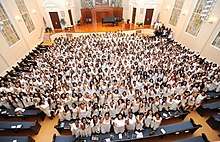
One of Spelman's oldest traditions are Spelmanites wearing "respectable and conservative" white dresses to designated formal events on campus. The tradition began in the early 1900s when it was customary for women to wear such dresses when attending formal events. White dresses are worn to the annual NSO induction ceremony, Founders Day Convocation, Alumnae March, and graduating seniors wear white dresses underneath their graduation gowns for Class Day and Commencement.[53]
Student publications and media
Spelman offers a literary magazine (Aunt Chloe: A Journal of Candor), a student newspaper, The BluePrint, and student government association newsletter (Jaguar Print).[48] The yearbook is called Reflections.
Religious organizations
Religious organizations currently registered on campus include: Baha'i Club, Al-Nissa, Alabaster Box, Atlanta Adventist Collegiate Society, Campus Crusade for Christ, Crossfire International Campus Ministry, Happiness In Praise for His Overflowing Presence, InterVarsity Christian Fellowship, Movements of Praise Dance Team, The Newman Organization, The Outlet and The Pre-Theology Society Minority.[48]
International student and social organizations
NAACP and Sister Steps are registered campus organizations.[48] Spelman also has chapters of Colleges Against Cancer, Circle K, Feminist Majority Leadership Alliance, Habitat for Humanity, National Council of Negro Women, National Society of Black Engineers, Operation Smile, United Way, and Young Democrats of America. Spelman is also the first HBCU to charter a chapter of Amnesty International on its campus.
Spelman has four chapters of National Pan-Hellenic Council sororities on campus: the Mu Pi Chapter of Alpha Kappa Alpha, the Eta Kappa Chapter of Delta Sigma Theta, the Beta Iota Chapter of Zeta Phi Beta, and the Epsilon Eta Chapter of Sigma Gamma Rho. Additionally, Spelman has the Iota Rho Chapter of Tau Beta Sigma National Honorary Band Sorority and the Eta Zeta Chapter of Gamma Sigma Sigma, a national service sorority. About three percent of students are active in Spelman's Greek system.[54]
Residential life
Spelman College has 11 residence halls on campus with approximately 1,400 students occupying them.[55] Each one has unique features and identities. There are three first-year students only residence halls, an honors residence hall (mixed with first-year students and upperclassmen), and seven upperclassmen only residence halls.[56] All first-year students and sophomores are required to live on campus and it is traditional for first-year students to engage in friendly residence hall competitions (i.e. stroll-offs, chant-offs, pranks, fundraising, etc.) throughout the school year.
Athletics
From 2003 to 2013 the Spelman Jaguars were a member of the Great South Athletic Conference (GSAC) of NCAA's Division III. The school sponsored seven varsity sports: basketball, cross country, golf, soccer, softball, tennis and volleyball. In 2013, Spelman College decided to drop varsity athletics and leave the National Collegiate Athletic Association. Using money originally budgeted to the sports programs, they created wellness programs available for all students.[57]
Notable alumnae and faculty
Spelman's notable alumnae include the first African-American COO of Starbucks and CEO of Sam's Club Rosalind Brewer, Pulitzer Prize winner Alice Walker, former Dean of Harvard College Evelynn M. Hammonds, activist and Children's Defense Fund founder Marian Wright Edelman, civil rights and criminal defense lawyer Dovey Johnson Roundtree, musician, activist and historian Bernice Johnson Reagon, political activist Stacey Abrams, writer Pearl Cleage, TV personality Rolonda Watts, opera singer Mattiwilda Dobbs, and actresses Cassi Davis, LaTanya Richardson, Adrienne-Joi Johnson, and Keshia Knight Pulliam.
References
- "List of HBCUs -- White House Initiative on Historically Black Colleges and Universities". August 16, 2007. Archived from the original on December 23, 2007. Retrieved January 3, 2008.
- "Spelman College". The New Georgia Encyclopedia. Georgia Humanities Council and the University of Georgia Press. Retrieved January 30, 2008.
- "Fact Book: Spelman College" (PDF). November 30, 2008. Archived from the original (PDF) on March 3, 2016. Retrieved November 28, 2009.
- As of June 30, 2019. "U.S. and Canadian 2019 NTSE Participating Institutions Listed by Fiscal Year 2019 Endowment Market Value, and Percentage Change in Market Value from FY18 to FY19 (Revised)". National Association of College and University Business Officers and TIAA. Retrieved April 18, 2020.
- "Financial statements" (PDF). www.spelman.edu. 2018. Retrieved July 19, 2019.
- https://www.spelman.edu/docs/oirap/mini-fact-book-2018-2019.pdf?sfvrsn=4b336f51_0
- Spelman College Visual Identity Standards (PDF). Retrieved March 8, 2018.
- "Spelman eliminates athletics in favor of campus-wide wellness initiative". Inside Higher Ed. November 1, 2012. Retrieved November 4, 2012.
- Wallace Putnam Reed, ed. (1889). History of Atlanta, Georgia: With Illustrations and Biographical Sketches of Some of Its Prominent Men and Pioneers. D. Mason & Company. pp. 367–370.
- Lefever, Harry G. (2005), "The Early Origins of Spelman College". The Journal of Blacks in Higher Education, No. 47, pp. 60-63.
- "Sophia B. Packard", Encyclopædia Britannica.
- "College History". Spelman.edu. Spelman College. Archived from the original on September 25, 2008. Retrieved July 2, 2008.
- Spencer, Taronda (February 1, 2004). "Spelman College". New Georgia Encyclopedia.
- "Spelman College Glee Club". Spelman.edu. Spelman College. Retrieved February 26, 2017.
- "History in Brief". Spelman.edu. Spelman College.
- Alice Walker remembers Howard Zinn, in the Boston Globe, January 31, 2010.
- Edelman, Marian Wright (2000), "Spelman College: A Safe Haven for a Young Black Woman". The Journal of Blacks in Higher Education, No. 27, pp. 118-123.
- "Campus Map – Spelman College". Spelman.edu. Retrieved July 11, 2018.
- "Atlanta's Spelman College ends Bill Cosby professorship". BBC. July 25, 2015. Retrieved July 27, 2015.
- "Spelman Discontinues Cosby Professorship". Inside Higher Ed. July 27, 2015. Retrieved July 27, 2015.
- "Spelman left spellbound by Michelle Obama". Ajc.com. Retrieved July 11, 2018.
- "Dr. Mary Schmidt Campbell Named President-elect of Spelman College". Spelman.edu. Retrieved July 11, 2018.
- http://www.carterusa.com/projects/spelman-college-read-hall-wellness-center
- Stirgus, Eric. "Spelman College to admit transgender female students". AJC. Retrieved May 20, 2019.
- "Spelman College Receives $30 Million Gift From Trustee Ronda Stryker and Spouse, William Johnston, to Support New Center for Innovation & the Arts". www.Spelman.edu. December 2018. Retrieved May 20, 2019.
- Harris, Adam (May 19, 2019). "What Happens When a Billionaire Swoops In to Solve the Student-Debt Crisis". The Atlantic. Retrieved May 20, 2019.
- https://www.prnewswire.com/news-releases/patty-quillin-and-reed-hastings-fund-200-full-scholarships-at-spelman-college-with-a-40-million-gift-301078698.html
- https://museum.spelman.edu/
- "PAST EXHIBITIONS". Spelman College Museum of Fine Art. Retrieved December 10, 2019.
- "Spelman College; Spelman College Museum of Fine Art Launches its 2017 Season with a Solo Exhibition Featuring Acclaimed Artist Beverly Buchanan." Health & Medicine Week, Sep 29, 2017, pp. 5897. ProQuest, https://login.ezproxy.auctr.edu:2050/login?url=https://search-proquest-com.ezproxy.auctr.edu/docview/1944379135?accountid=8422.
- "Spelman's New Curatorial Studies Program Addresses Critical Museum Industry Diversity Gap". www.spelman.edu.
- "America's Top Colleges 2019". Forbes. Retrieved August 15, 2019.
- "U.S. College Rankings 2020". Wall Street Journal/Times Higher Education. Retrieved September 26, 2019.
- "Best Colleges 2020: National Liberal Arts Colleges Rankings". U.S. News & World Report. Retrieved September 8, 2019.
- "2019 Liberal Arts Rankings". Washington Monthly. Retrieved September 8, 2019.
- "Spelman College Rankings". U.S. News & World Report. 2020. Retrieved September 16, 2019.
- "Robust 2016 Funding Fuels Spelman's Rigorous Research, Programs, and Initiatives Focused on STEM". Spelman.edu. Retrieved July 11, 2018.
- "Mathematics – Spelman College". Spelman.edu. Retrieved July 11, 2018.
- "Learn about the Top Women's Colleges in the U.S." Collegeapps.about.com. Retrieved July 11, 2018.
- "Strategic Partnerships | Spelman College". www.spelman.edu.
- "College of Law Enters into 3+3 Admissions Agreements with Three Historically Black Colleges, Universities".
- "Admissions – SPELMAN COLLEGE". Sites.spelman.edu. Retrieved July 11, 2018.
- "Research Programs – Spelman College". Spelman.edu. Retrieved July 11, 2018.
- "Archived copy" (PDF). Archived from the original (PDF) on September 19, 2017. Retrieved September 19, 2017.CS1 maint: archived copy as title (link)
- "Error Page – Spelman College" (PDF). Spelman.edu. Retrieved July 11, 2018.
- "The Spelman Promise" (PDF). Spelman.edu. Retrieved February 28, 2019.
- https://www.spelman.edu/about-us/at-a-glance
- "USNews.com:America's Best Colleges 2008:Spelman College:Extracurriculars". USNews.com. U.S.News & World Report, L.P. Retrieved January 30, 2008.
- "Spelman College Rankings". US News & World Report. Retrieved July 18, 2019.
- "Google". Google.com. Retrieved July 11, 2018.
- https://www.spelman.edu/admissions/frequently-asked-questions
- "New Student FAQs". Spelman.edu. Retrieved July 11, 2018.
- "The White Attire Tradition – Spelman College". Spelman.edu. Retrieved July 11, 2018.
- https://www.usnews.com/best-colleges/spelman-college-1594/student-life
- "Archived copy" (PDF). Archived from the original (PDF) on November 9, 2017. Retrieved November 8, 2017.CS1 maint: archived copy as title (link)
- "Residence Halls – Spelman College". Spelman.edu. Retrieved July 11, 2018.
- Luke Cyphers, "A Different World", SB Nation, April 16, 2013.
Further reading
- Atlanta Regional Council for Higher Education. "Giving Voice to a New Generation: Metro Atlanta's three women's colleges are going strong, even while the number of women's colleges nationwide has declined."
- Guy-Sheftall, Beverly. "Black Women and Higher Education: Spelman and Bennett Colleges Revisited." The Journal of Negro Education, Vol. 51, No. 3, The Impact of Black Women in Education: An Historical Overview (Summer, 1982), pp. 278–287.
- Johnetta Cross-Brazzell, "Brick without Straw: Missionary-Sponsored Black Higher Education in the Post-Emancipation Era," Journal of Higher Education 63 (January/February 1992).
- Beverly Guy-Sheftall and Jo Moore Stewart, Spelman: A Centennial Celebration, 1881–1981 (Atlanta: Spelman College, 1981).
- Albert E. Manley, A Legacy Continues: The Manley Years at Spelman College, 1953–1976 (Lanham, Md.: University Press of America, 1995).
- Florence M. Read, The Story of Spelman College (Princeton, N.J.: Princeton University Press, 1961).
- Spelman College Aiming for New Heights – Atlanta Journal-Constitution article
- The New Georgia Encyclopedia